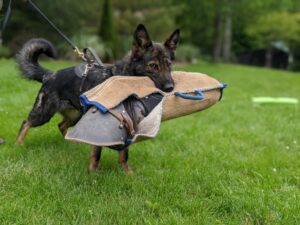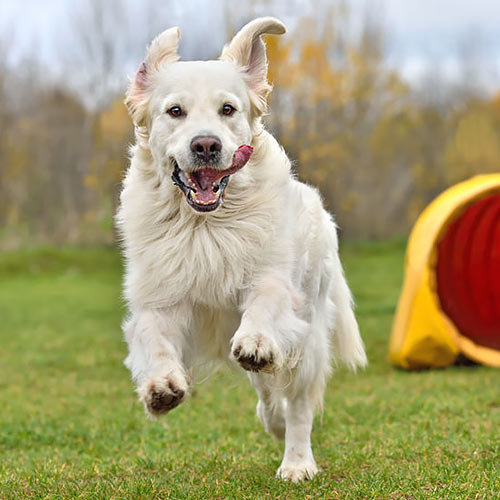So, you have decided or may be deciding to get a working dog. If you’re ready for it, this is one of the smartest decisions you’ll ever make. If you’re not ready for it, it can be one of the most frustrating things you’ve ever done. Let us give you some words of tried/true wisdom!
First, let’s a define a working dog. A true working dog is genetically capable of performing the task/s she is to engage in. That may include detection work, bite work, protection dogs, police dogs, and may include some competition dogs. Most times, a dog that is involved in show/aesthetics is not a true working dog and, most times, dogs who compete in shows and protection work are typically not true working dogs. They are simply dogs who happen to be able to do a bit of bitework but are predominantly bred for their show qualities.
Second, if it’s a working German Shepherd dog, well…hang on to that thought for a moment. We realize there are other breeds of working dogs but since we have trained/bred/raised GSDs for over 30 years, we’ll mainly approach the article from that perspective. OK, so back to our point. When you purchase a working dog, you’re not only getting a dog that is genetically superior but temperamentally sound. Those who come from a knowledgeable and reputable breeder will also be physically superior; that is less inbreeding, fewer health problems, and typically truer to the breed’s original standard. He has a straight back, not a sloped or roached back, not a dog that walks as though he has a 2×4 stuck in his rectum, not half dog half frog.
If a working dog is to excel, he will require your involvement and engagement. He will not do well in a hands-off approach. He will need your leadership; that is, your instruction on what the rules/boundaries are and the enforcement of those rules/boundaries. If you are fair and firm and know how to handle this kind of dog, she will happily reside within those boundaries. She needs your training. Professional training can help but you must provide that structure of training within your own lifestyle. In other words, it’s not a push-button solution. Getting help from a trainer is beneficial but the dog is only 50% of the team. You are the other 50% of the team. You must keep up your obligations as well as the dog.
Furthermore, you must not force this dog into a sappy, house-imprisoned existence. He/she will need exercise, both physical and mental. You will need to provide this or they will create it…in ways that are not typically acceptable to us (for example, the Malinois who chews the back of the couch to shreds – he’s bored, give him a job to do).
A word to the wise: working dogs and lazy people do not mix. Physically, again, they need something to do. It could be agility, tracking, bitework, herding, or any number of activities. Additionally, working dogs are quick learners. They are specifically bred to be mentally sharp. Many times, they are mentally ahead of their owners. If you cannot provide the mental leadership, please do not get a working dog.
Keep in mind that what is considered a temperament fault in other breeds may be normal for your working dog. One example, working dog breeds can be territorial. If you cannot tolerate him/her being territorial, do not get a working breed. Or at least learn how to channel that genetic urge and teach him/her when it is appropriate and when it is not. That is your responsibility. You will be doing yourself and your dog a huge disservice if you force him to learn this on his own!
Another commonality among many working breeds is their desire to chase and possibly nip. This is not aggression. This is the dog exercising his genetic instinct to pursue his prey. It may be more difficult for this type of dog to tolerate cats or other quick-moving pets. You will need to accept that…or don’t get a working dog. Moreover, he may express his inbred desire to “herd,” especially herding small children. If this is intolerable to you, do not get a herding breed (the group from which many working dogs come from). Some of these breeds can also “nip,” which can be dealt with constructively by training. Nipping is not aggression. Please don’t confuse nipping with biting. Yes, nipping and biting are two very different things with different motives and different goals.
At times, working dogs will drive you crazy. Their endless energy will surprise most people. These dogs have been bred to work all day long but still protect the family all night long. You will need to learn to see the beauty of interacting with this kind of dog. Their joy of tug work, chasing tennis balls (or anything that moves), carrying toys in their mouth, being wary of strange dogs and people, putting their nose to the wind and seeking out an odor that interests them, constantly being on guard, and taking life seriously at times are all a part of an expression of who they are.
These dogs need training. They typically need training from someone experienced with working dogs. The average pet trainer isn’t going to know how to truly handle this kind of dog. Their lack of knowledge on the subject can actually make matters worse. Conifer Canine can certainly help with the training of your working dog. Our staff consists of Master Trainers who have years of experience working with working dogs.
Also, we offer solid working dog prospects: German Shepherds and Malinois, both from true, proven, successful, healthy working lines.
The working dog is, in many ways, a high-class dog. Provide for this dog as he deserves and you will have the smartest, strongest, liveliest, most receptive, most balanced dog you’ve ever had!


